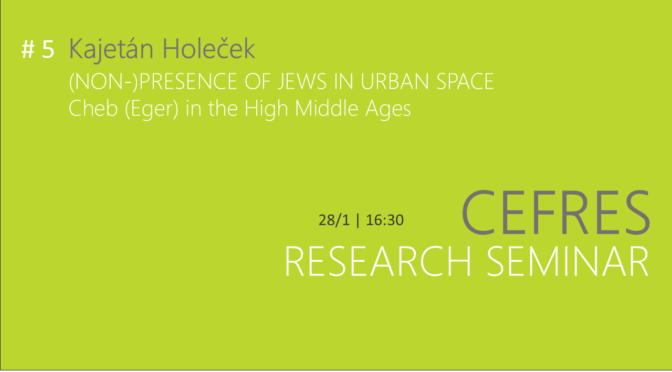La (non-)présence des Juifs dans l’espace urbain médiéval
5th session of CEFRES in-house seminar
Through the presentation of works in progress, CEFRES’s Seminar aims at raising and discussing issues about methods, approaches or concepts, in a multidisciplinary spirit, allowing everyone to confront her or his own perspectives with the research presented.
Location: CEFRES Library and online (to register and get the text: cefres[@]cefres.cz)
Date: Tuesday, January 28, 2025, at 4:30 p.m.
Language: English
It wll be hosted by:
Kajetán HOLEĆEK (CEFRES / Faculty of Arts, Charles University)
and chaired by Petr GIBAS (Masaryk University, Brno/, Institute of Sociologyy, Czech Academy of Sciences)
Text to be commented: Lars Frers, « The Matter of Absence », Cultural Geographies 20/4 (2013), p. 431–445.
Abstract
The history of Jews offers numerous avenues for scholarly exploration. Traditionally, researchers have focused on the physical presence of Jews within society, emphasizing the existence of Jewish communities in specific locations, their interactions with other Jews, Christians, or Muslims, their economic roles, and their legal status within the broader social framework. In my research, however, I have chosen a different approach to understanding Jewish history—one that examines the Jewish experience within urban social space. As an example, I have chosen the town of Cheb (Eger), which hosted a significant and sizable Jewish community from the 13th to the 15th century.
The social space of the medieval town cannot be understood merely as a geographical or topographical category; it constitutes a complex network of interpersonal relationships that give rise to social space itself. As H. Lefebvre eloquently states, social space “subsumes things produced and encompasses their interrelationships in their coexistence and simultaneity.” Drawing on Lefebvre’s analysis of the production of social space, my research focuses on the ways in which the Jewish population contributed to this process. As in many other cases, the history of the Jewish community in Cheb (Eger) is marked by numerous discontinuities. However, rather than viewing these discontinuities as obstacles, I argue that they accentuate the significance of (non-)presence in the production of social space, particularly through the varying degrees of antagonism between Christian and Jewish societies.
The boundary between the presence and absence of Jews in the social space of medieval towns proves to be remarkably fluid. The presence of Jews (or any other social group) generally signifies active participation in shaping space, especially through everyday activities and interpersonal interactions. Conversely, their absence does not imply a complete withdrawal or disappearance from space. Instead, it reveals their passive role, which nonetheless continues to shape social space through the ways in which absence is perceived and reflected upon by the surrounding community.
My presentation will be divided into three parts. First, I will introduce my central research question, which I formulate as follows: “What was the experience of Jews in Eger’s urban space? How did the (non-)presence of Jews contribute to the production of social space in the medieval town?” Next, I will elaborate on my methodological approach, which draws on Henri Lefebvre’s The Production of Space as well as on insights from cultural geography concerning the study of (non-)presence. In the final part, I will present specific examples from my dissertation to demonstrate how I apply this methodology to the study of medieval society.
I contend that, despite the specific characteristics associated with the Middle Ages and Jewish history, this research can illuminate processes that remain relevant to contemporary society.

